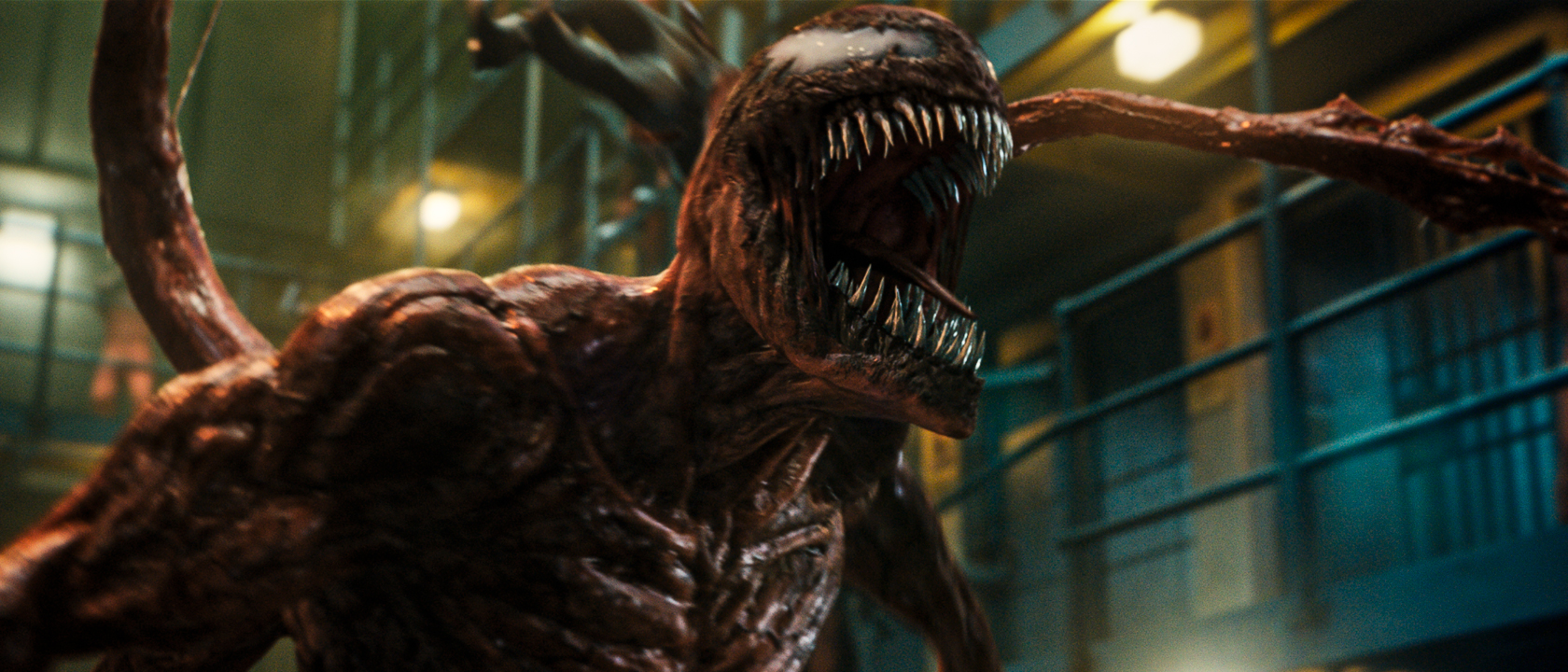To be brief but blunt, Ruben Fleischer’s Venom is a laughably bad movie. Beyond being tonally inconsistent and visually unpleasant, it has a story that never feels fully thought out and is riddled with ridiculous holes. Still, however, the blockbuster ended up being a big enough box office hit to demand a sequel. Hence, Andy Serkis’ Venom: Let There Be Carnage.
This in mind, the new film is conceptually a second chance. The titular main character, who has been popular on the pages of Marvel Comics since the early 1990s, unquestionably has a lot of big screen potential, but little of it was on display in the 2018 origin movie. In an ideal world, the producers behind the budding franchise would have taken the development of the follow-up as an opportunity to analyze what worked and what didn’t the first time around, and then use those lessons to produce a vastly superior feature. Sadly, what audiences are getting as Venom 2 is not a result of that kind of optimistic scenario.
Venom: Let There Be Carnage is certainly an improvement on its predecessor, but that’s primarily in its ability to execute a mostly coherent story. Rather than really make an effort to change things, the production clearly saw the previous movie’s success as validation of its bad choices, so it regularly succumbs to many of the same issues – maintaining the air of bad mid-aughts comic book movies like Mark Steven Johnson's Daredevil, Tim Story’s Fantastic Four, and Jonathan Hensleigh's The Punisher.
Written by Kelly Marcel, who also worked on the script for Venom, the new film fulfills the plot promised by the end credits scene in the antecedent feature, and begins with Eddie Brock (Tom Hardy) finding his life become entangled with psychotic serial killer Cletus Kassidy (Woody Harrelson). Serving time in San Quentin, the maniac says that Eddie is the only person that he will talk to, and the reporter/anti-hero is encouraged to do the interview by a detective (Stephen Graham) who is hoping that the conversation will reveal the location of Cletus’ victims.
Cletus’ actual goal is to get a secret message out to the woman he loves – Frances Barrison a.k.a. Shriek (Naomi Harris), who is locked up at the secretive Ravencroft Institute – but Venom gives Eddie a leg up in the interaction when he notices some artwork carved in the walls of the killer’s cell. Doing some investigating results in the protagonist finding the missing bodies without Cletus’ help, and in the wake of the discovery the governor of California makes the decision to lift the state’s moratorium on the death plenty and end the murderer’s life.
While Eddie is happy to rediscover success in his journalism career, the incident exacerbates issues between him and his symbiote. Venom is already upset because he’s not allowed to willfully go around eating people, and then he feels underappreciated when he doesn’t get any credit for his contribution to the discovery. As it turns out, this strife couldn’t come at a worse time, as Cletus blames Eddie for his imminent lethal injection (despite their extremely limited interaction), and during a death row confrontation the soon-to-be villain bites the reporter on the arm. From this nibble a new symbiote is born, and the killer uses his new friend to be reunited with Frances – slaughtering anything that gets in his way.
Venom: Let There Be Carnage leans into goofiness at the expense of any tension and horror
On some level you can understand what the movie does with Venom, as it’s a case of an adaptation making a choice for a character and sticking with it, but the treatment of Carnage is far less excusable. Obviously certain expectations have to be tempered going into Venom: Let There Be Carnage knowing that the blockbuster is rated PG-13, but not being able to show blood is no justification for abandoning the idea that the sadistic, homicidal villain is a terrifying individual. Woody Harrelson may not be sporting the clown wig he wore in the end credits scene of Venom, but he carries the spirit of it through his performance regardless.
In the comics, a clash between Venom and Carnage is a clash between two of Spider-Man’s scariest foes, and you’d hope the threat level of that would translate to the big screen – but it’s just not in the cards in the way in which this film approaches the material. It’s not overly surprising that the sequel maintains the weird comedic banter between Eddie Brock and his symbiote, as that was one of the few redeeming qualities of the 2018 movie, but it also makes the mistake of stomping on the gas pedal. One can appreciate Venom getting frustrated about only eating chocolate and live chickens and craving more of a life, but it goes too far when he is getting on stage at a masquerade party and has a shtick-y “drop the mic” moment.
This is the big screen version of Carnage nobody asked for.
Fans have been waiting literal decades to see the unhinged insanity and chaos of Carnage brought to life on the big screen, but I’d be willing make a bet that most haven’t been exhibiting patience in anticipation of Cletus Kassidy spending the majority of his screen time pining for his lost love and whining about how Eddie never reported on his abusive childhood. And even when he is donning the red symbiote and stirring up some violence, there are no acts he commits that are any more vicious or brutal than what audiences saw Venom, the hero, do in the first movie.
Let There Be Carnage reaffirms that it’s really hard to make compelling action centering around two blobs with teeth.
Given the dampened natures of the eponymous characters, their clash in this movie is already deprived of stakes and tension, but it also suffers from the same visual issues that plagued the prior chapter. Just before the big final battle, Venom is reticent to enter the fight because of some unexplained fear of the “red ones,” suggesting something special about that color, but that’s not something we ever get to see, as once again symbiote fights are reduced to skirmishes between human-shaped goo that don’t effectively translate damage or dynamic shifts. It’s understandably not an easy cinematic problem to solve, but it still matters that Venom: Let There Be Carnage doesn’t solve it.
It’s a blockbuster that is surely going to create some divisive reactions, as those who can turn a blind eye to the litany of overwhelming problems in Venom will likely be able to do the same mental gymnastics necessary to be equally entertained by Venom: Let There Be Carnage. For the more discerning audiences hoping that the film will be a big step up, however, you’re best off doing some extreme tampering of your expectations right now, or better yet just skip it altogether.

Eric Eisenberg is the Assistant Managing Editor at CinemaBlend. After graduating Boston University and earning a bachelor’s degree in journalism, he took a part-time job as a staff writer for CinemaBlend, and after six months was offered the opportunity to move to Los Angeles and take on a newly created West Coast Editor position. Over a decade later, he's continuing to advance his interests and expertise. In addition to conducting filmmaker interviews and contributing to the news and feature content of the site, Eric also oversees the Movie Reviews section, writes the the weekend box office report (published Sundays), and is the site's resident Stephen King expert. He has two King-related columns.











